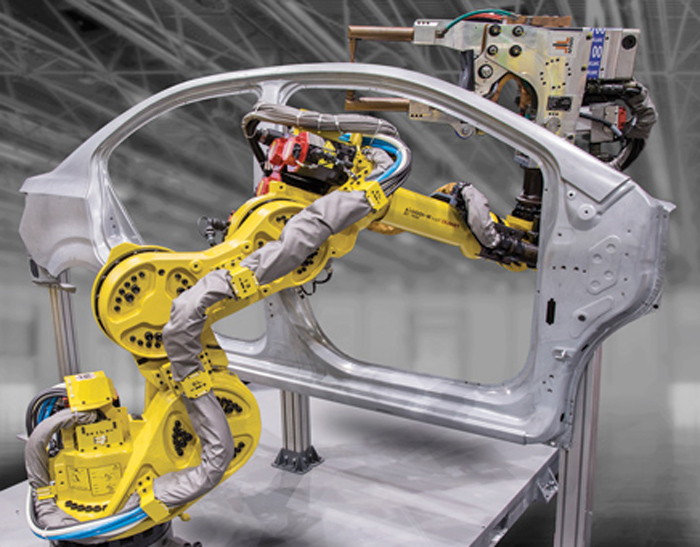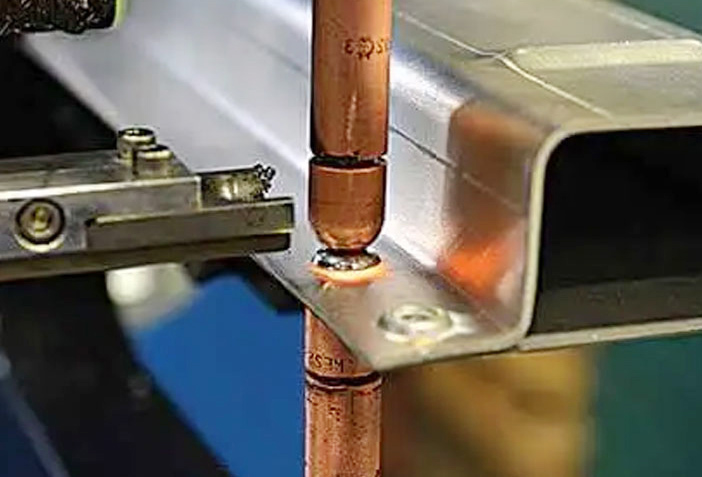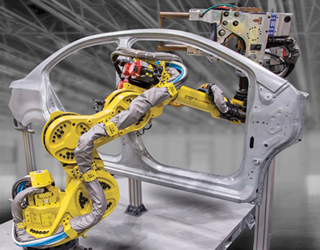Spot welding, a fundamental process in automotive manufacturing, involves the joining of metal sheets using high-voltage electrical currents. This technique creates rapid and robust bonds, making it a cornerstone of vehicle assembly. The process is essential for constructing vehicle components, such as the chassis and body panels, ensuring both structural integrity and aesthetic appeal. By understanding the intricacies of spot welding, we can appreciate its pivotal role in the automotive industry.
Spot welding’s significance lies in its ability to produce consistent and durable joints, essential for the safety and longevity of vehicles. The process enables manufacturers to efficiently assemble metal components, contributing to the overall strength and resilience of the vehicle. This precision-driven technique ensures that the vehicle’s structural elements are securely bonded, meeting stringent safety standards. Understanding the importance of spot welding provides insight into the meticulous craftsmanship behind every vehicle.

Photos by mfgnewsweb.com
The automotive industry employs various spot welding techniques to address specific manufacturing needs. These techniques include resistance spot welding, projection welding, and capacitive discharge welding, each offering unique advantages for different applications. By utilizing these diverse methods, manufacturers can tailor their approach to suit the specific requirements of various vehicle components. Understanding the nuances of these techniques empowers manufacturers to make informed decisions in the production process, optimizing the quality and efficiency of automotive spot welding.
Importance of Spot Welding in Automotive Manufacturing
The importance of spot welding in automotive manufacturing cannot be overstated. This technique plays a pivotal role in ensuring the structural integrity, safety, and longevity of vehicles. By creating robust and seamless joints, spot welding contributes to the overall durability and resilience of the vehicle. Furthermore, the precision and efficiency of spot welding are vital for maintaining high production standards, meeting the demands of a competitive automotive market.
Spot welding is instrumental in the assembly of critical vehicle components, including the chassis, body panels, and intricate structural elements. The technique’s ability to swiftly and securely join metal sheets is paramount in achieving the desired strength and aesthetic appeal of the final product. This level of precision is crucial for upholding the safety and performance standards expected of modern vehicles. Recognizing the importance of spot welding underscores its indispensable role in automotive manufacturing.
Spot welding offers a cost-effective and time-efficient method for joining metal components, contributing to streamlined production processes. The technique’s reliability and consistency in creating strong bonds make it an essential component of automotive manufacturing. The significance of spot welding extends beyond mere assembly; it underpins the very foundation of vehicle construction, ensuring that every vehicle meets the highest standards of quality and safety.
Types of Spot Welding Techniques Used in Automotive Industry
In the automotive industry, spot welding encompasses various techniques, each tailored to specific manufacturing requirements. Resistance spot welding, the most widely used method, applies pressure and electrical current to join metal sheets. This technique is ideal for high-volume production and is particularly suited for welding steel components. Projection welding, on the other hand, creates welds at specific points, making it suitable for joining complex or irregularly shaped components. Capacitive discharge welding, with its rapid energy release, is favored for welding lightweight materials, such as aluminum.
These diverse spot welding techniques cater to the range of materials and design complexities encountered in automotive manufacturing. By understanding the distinct advantages of each method, manufacturers can select the most suitable approach for different components, optimizing the quality and efficiency of the welding process. The versatility of these techniques empowers automotive manufacturers to address the diverse welding challenges posed by modern vehicle construction.
The continuous evolution of spot welding techniques in the automotive industry underscores the drive for innovation and efficiency. Advanced methods, such as laser welding and ultrasonic welding, offer enhanced precision and flexibility, expanding the capabilities of spot welding in automotive manufacturing. These cutting-edge techniques are revolutionizing the industry by addressing the demand for lightweight materials and intricate designs, paving the way for the next generation of automotive assembly technologies.
Advantages of Spot Welding in Automotive Manufacturing
The advantages of spot welding in automotive manufacturing are multifaceted, encompassing structural integrity, production efficiency, and material versatility. One of the primary benefits is the creation of robust and durable joints, essential for ensuring the safety and resilience of vehicles. The seamless integration of metal components through spot welding contributes to the overall strength and stability of the vehicle, meeting rigorous industry standards.
Spot welding offers a high degree of production efficiency, enabling rapid assembly of vehicle components. The process’s ability to swiftly join metal sheets with minimal heat-affected zones streamlines the manufacturing process, contributing to cost-effective and time-efficient production. This efficiency is crucial for meeting the demands of a dynamic automotive market while upholding stringent quality control measures.
Additionally, spot welding’s versatility in joining various materials, including steel and aluminum, makes it an indispensable technique in automotive manufacturing. This adaptability allows manufacturers to address the diverse material requirements of modern vehicles, optimizing the strength-to-weight ratio and overall performance. Understanding the advantages of spot welding underscores its pivotal role in shaping the structural and functional attributes of contemporary vehicles.

Photos by blvengineering.com.au
Factors Influencing the Quality of Spot Welding in Automotive Applications
The quality of spot welding in automotive applications is influenced by various factors, ranging from material properties to process parameters. Material thickness, composition, and surface condition play a critical role in determining the weld quality, as they directly impact the welding process’s stability and strength. The choice of electrodes, welding current, and pressure settings further influence the quality of spot welds, necessitating meticulous control and monitoring.
Environmental factors, such as ambient temperature and humidity, can affect the welding process and the resulting joint quality. Proper environmental control is essential to ensure consistent and reliable spot welds, particularly in large-scale automotive manufacturing facilities. Understanding and addressing these influential factors are crucial for maintaining the high standards of spot welding quality required in automotive applications.
Furthermore, technological advancements, such as real-time monitoring and feedback systems, have emerged to enhance the quality control of spot welding in automotive manufacturing. These innovations enable manufacturers to continuously assess and optimize the welding process, ensuring the production of high-quality spot welds with minimal variability. By comprehensively addressing the factors influencing spot welding quality, automotive manufacturers can uphold the integrity and performance of their vehicles.
Common Challenges and Solutions in Automotive Spot Welding
Automotive spot welding, despite its numerous advantages, presents inherent challenges that manufacturers must navigate. One common challenge is the occurrence of weld defects, such as burn-through, expulsion, or incomplete fusion, which can compromise the integrity of the weld joint. These defects often stem from inadequate process control or material inconsistencies and require systematic troubleshooting and corrective measures.
Another challenge is the need to accommodate the increasing use of lightweight materials, such as aluminum, in vehicle construction. Spot welding these materials demands precise control of process parameters and specialized techniques to ensure optimal joint quality and structural integrity. Meeting this challenge involves adapting welding processes, equipment, and training to address the unique characteristics of lightweight materials.
To overcome these challenges, automotive manufacturers are embracing advanced welding technologies and automation systems. Robotics and advanced control systems offer precise and consistent spot welding, reducing variability and enhancing overall weld quality. Additionally, continuous training and skill development for welding personnel are essential to address evolving challenges and ensure the highest standards of spot welding in automotive manufacturing.
Innovations in Automotive Spot Welding Technology
Innovations in automotive spot welding technology are revolutionizing the manufacturing landscape, enhancing precision, efficiency, and adaptability. Laser welding, an advanced technique gaining prominence in the automotive industry, offers unparalleled precision and minimal heat-affected zones, making it ideal for welding lightweight materials and intricate designs. This technology represents a leap forward in automotive spot welding, catering to the evolving demands of modern vehicle construction.
The integration of advanced monitoring and control systems, such as machine learning algorithms and real-time feedback mechanisms, is driving significant improvements in spot welding quality and consistency. These innovations empower manufacturers to optimize process parameters and adapt to varying material characteristics, ensuring the production of high-quality spot welds in automotive applications. The continuous evolution of spot welding technology underscores its pivotal role in shaping the future of automotive manufacturing.
Moreover, developments in automation and robotics are streamlining spot welding processes, enhancing productivity and precision. Automated welding systems offer consistent and repeatable performance, mitigating variability and optimizing production efficiency. These innovations are reshaping the automotive manufacturing landscape, setting new benchmarks for spot welding technology and its vital role in vehicle construction.
Outsourcing vs. In-House Spot Welding in Automotive Manufacturing
The decision to outsource spot welding or establish in-house welding capabilities in automotive manufacturing involves a careful evaluation of various factors, including production volume, technical expertise, and cost considerations. Outsourcing spot welding to specialized service providers can offer flexibility, particularly for low to medium production volumes, allowing manufacturers to access specialized expertise and resources without substantial capital investment.
Conversely, establishing in-house spot welding capabilities provides manufacturers with greater control over the welding process, quality assurance, and production timelines. In-house capabilities offer the advantage of direct oversight and customization, enabling manufacturers to tailor welding processes to specific component requirements and production schedules. This approach is particularly beneficial for high-volume production and specialized welding needs.
The decision between outsourcing and in-house spot welding is also influenced by the level of technical expertise and equipment investment required. For complex or specialized welding processes, in-house capabilities may be preferred to ensure precise control and adherence to stringent quality standards. Conversely, outsourcing may be more cost-effective and practical for standard spot welding requirements, allowing manufacturers to focus on core production activities.
Ultimately, the decision hinges on a comprehensive assessment of production needs, technical capabilities, and long-term business strategies, ensuring that manufacturers have the most suitable spot welding solution for their automotive manufacturing operations.
Conclusion and Future Outlook for Automotive Spot Welding
Automotive spot welding represents the pinnacle of precision and efficiency in vehicle construction, playing a vital role in ensuring the structural integrity, safety, and durability of vehicles. The significance of spot welding extends beyond mere assembly; it underpins the very foundation of automotive manufacturing, shaping the resilience and performance of modern vehicles. Understanding the intricacies and advancements in spot welding technology is essential for automotive manufacturers to meet the evolving demands of the industry.
Looking ahead, the future of automotive spot welding is poised for further innovation and advancement. The integration of advanced welding techniques, such as laser welding and ultrasonic welding, will continue to redefine the capabilities of spot welding in addressing lightweight materials and complex designs. Automation and robotics will play an increasingly prominent role, enhancing precision and productivity in spot welding processes, setting new benchmarks for efficiency and quality in automotive manufacturing.
